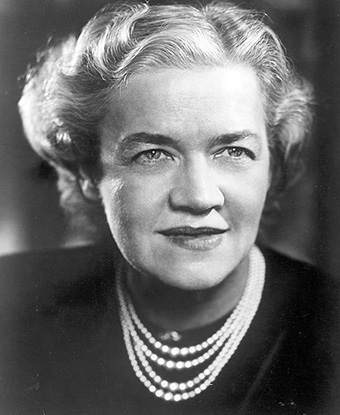Last updated: July 15, 2020
Person
Margaret Chase Smith

US Senate Historical Office. Public Domain.
Margaret Chase was born and grew up in Skowhegan, Maine where she attended school. After graduating high school, she taught briefly at a local one-room schoolhouse. In 1919, she joined the staff of the town’s weekly newspaper, the Independent Reporter as the circulation manager. She left the paper in 1928, and in 1930 married Clyde Smith, the paper’s owner.
Margaret became active in politics, and in 1930 was elected to the Maine Republican State Committee, serving through 1936 when Clyde was elected to the US House of Representatives. Margaret moved to Washington, DC with her husband, where she served as his secretary and speech writer. When Clyde suffered a heart attack early in 1940, he asked Margaret to run for his House seat. He died on April 8, and Margaret won the following special election. Three months after the special election, she won the regular election with more than 60% of the vote.
She was the first woman to serve in both houses of the United States Congress and the first woman to represent Maine in either. From 1940 to 1949, she was a U.S. Representative in the House representing Maine’s 2nd District. During her victorious 1948 campaign for Senate, she was faced with considerable anti-woman bias – despite her insistence that her gender had nothing to do with her running for office. “The little lady… is simply over-reaching herself,” wrote one reporter. When she was asked whether a woman could make a good Senator, Smith replied, “Women administer the home. They set the rules, enforce them, mete out justice for violations. Thus, like Congress, they legislate; like the Executive, they administer; like the courts, they interpret the rules. It is an ideal experience for politics.” [1]
From 1949 to 1973, Smith represented Maine in the U.S. Senate, and from 1967 until 1973 served as the Chair of the Senate Republican Conference. She was the longest-serving woman in Senate history until 2011, when Senator Barbara Mikulski was sworn into her fifth term. Margaret Chase Smith remains the longest-serving Republican woman in the Senate.
In 1946, Smith became a member of the House Armed Services Committee. During her time on this Committee, she sponsored and helped pass the Women’s Armed Services Integration Act. This Act was signed into law by President Truman in June of 1948. It enabled women to serve as permanent, regular members of the armed forces (Army, Navy, Marine Corps, Air Force). Although they could serve, the law excluded women from ships and planes that might engage in combat. Before the Women’s Armed Services Integration Act, women (except nurses) served in the military only during times of War.
Smith was an early critic of McCarthyism during the Red and Lavender Scares of 1947 through 1957. These scares were fueled by several high-ranking US government officials admitting to spying for the Soviet Union. Senator Joseph McCarthy and members of his House Committee on Un-American Activities capitalized on this fear to purge the federal government of “undesirables.” Those accused of Communism or Communist sympathies (Red Scare) and of being homosexual (and therefore seen as easily blackmailed to become a Soviet spy – the Lavender Scare) were forced out of their jobs and housing. Supportive of rooting out foreign influence, Smith became disillusioned when McCarthy and his cronies refused to provide evidence of Communists and Communist interference in the US government. In 1945, Margaret Smith voted against making the House Committee on Un-American Activities permanent. In 1950, she gave a speech called the “Declaration of Conscience” in which she identified some of the basic principles of Americanism:
- The right to criticize
- The right to hold unpopular beliefs
- The right to protest
- and the right of independent thought[2]
In January 1964, Smith announced her candidacy for President of the United States. Although she was not selected as the Republican Party presidential candidate, she was the first woman in the United States to be in the running to be a major party’s presidential candidate (in 1972, Shirley Chisholm became the first woman to be considered as the Presidential candidate for the Democratic Party).
In her later career, Margaret Chase Smith supported increased education funding, civil rights, and Medicare. She also argued for the use of nuclear weapons against the Soviet Union, and was an active supporter of NASA and the space program.
In 1972, she lost the election for her seat in the US Senate and retired from Congress in January 1973.
In July 1989, President George H. W. Bush awarded Margaret Smith with the Presidential Medal of Freedom – the highest civilian award of the United States. The medal is awarded to those who have made especially noteworthy contributions to the security or national interests of the United States, to world peace, or to cultural or other significant endeavors.
Margaret Chase Smith died at age 97.
References
[1] United States Senate. “First Woman Elected to Both Houses of Congress” https://www.senate.gov/artandhistory/history/minute/First_Woman_Both_Houses.htm
[2] Smith, Margaret Chase. “Declaration of Conscience,” delivered June 1, 1950, Washington, DC. Available at American Rhetoric https://www.americanrhetoric.com/speeches/margaretchasesmithconscience.html
